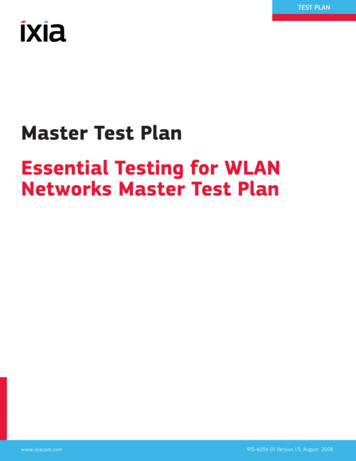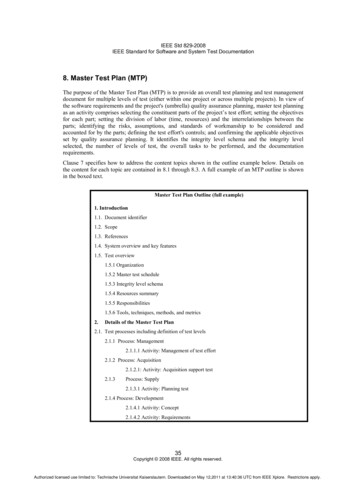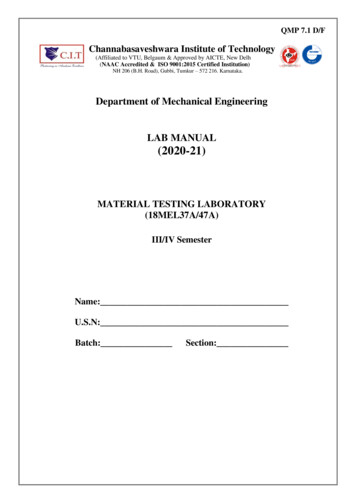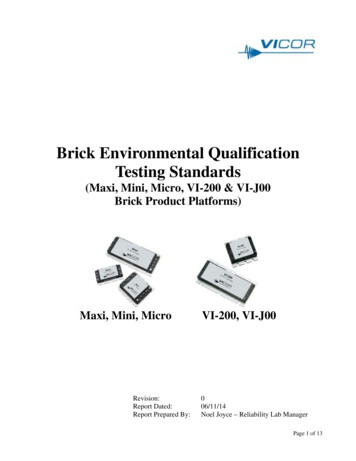
Transcription
TEST PLANMaster Test PlanEssential Testing for WLANNetworks Master Test Planwww.ixiacom.com915-6054-01 Version 1.5, August 2008
Master Test PlanVersion HistoryDateVersionComments03/21/20071.1Initial Release1.3Modified and extended a/b/g Test Cases from Version 1.1Added 3 new QoS Functional Test CasesAdded Test Case Profiles applicable to a specific SUTconfiguration or a specific test area1.4Added Power Save Transition test casesCompleted System and Stress test case sectionsCompletes 802.11a/b/g test plan1.5Added 802.11n Test CasesModified Power Save and QoS Test cases to useWaveDynamixRemoved Test Cases involving non-productized scripts08/08/200710/18/200708/20/2008 2008 Veriwave, inc.PAGE 2 OF 308
Master Test PlanTable of ContentsIntroduction . 9Goals . 10SUT Overview . 10VeriWave Applications . 11Data Plane . 12Unicast Throughput . 12Unicast Forwarding Rate . 13Unicast Packet Loss . 13Unicast Latency . 13TCP Goodput . 14Control Plane. 14Benchmark Roaming . 14Stress Association Database Capacity (Client Capacity) . 15QoS . 15VoIP QoS Service Capacity . 15VoIP Service Assurance . 16VoIP Roaming . 16Mesh . 17Mesh client capacity . 17Mesh VoIP call capacity . 17Mesh Throughput per hop . 18Mesh Forwarding Rate per hop . 18Mesh Latency per hop . 18Mesh Backhaul Failover (Self-healing) . 18Miscellaneous . 18AAA Authentication Load . 18Test-bed Configuration . 19Test Case Profiles . 20Single-AP Test Profile . 21Mesh Test Profile . 24QoS Test Profile . 26Roaming Test Profile . 27Test Plan . 28Functional Verification . 28Association . 28ATC 001 Basic 80211a-mode Association . 29ATC 002 Basic 80211bg-mode Association . 30ATC 003 Basic 80211b-only-mode Association . 32ATC 004 Basic 80211g-only-mode Association . 33ATC 005 Mixed 80211ag-mode Association . 35ATC 006 Mixed 80211ab-mode Association . 36 2008 Veriwave, inc.PAGE 3 OF 308
Master Test PlanATC 007 Mixed 80211bg-mode Association . 38ATC 008 Basic 80211n-mode Association . 40ATC 009 Mixed 80211n-and-Legacy Association . 41Security and DHCP . 43STC 001 Security Baseline Test . 44STC 002 Open WEP40 . 45STC 003 Open WEP128 . 47STC 004 Shared-Key WEP40 . 48STC 005 Shared-Key WEP128 . 50STC 006 DWEP EAP-TLS. 52STC 007 DWEP EAP-TTLS . 54STC 008 DWEP PEAP-MSCHAPv2 . 55STC 009 LEAP . 57STC 010 WPA PSK And WPA PSK AES . 59STC 011 WPA EAP-TLS And WPA EAP-TLS AES . 60STC 012 WPA EAP-TTLS . 62STC 013 WPA PEAP-MSCHAPv2 And WPA PEAP-MSCHAPv2 AES . 64STC 014 WPA EAP-FAST . 66STC 015 WPA LEAP . 68STC 016 WPA2 PSK And WPA2 PSK TKIP . 69STC 017 WPA2 EAP-TLS And WPA2 EAP-TLS TKIP . 71STC 018 WPA2 EAP-TTLS . 73STC 019 WPA2 PEAP-MSCHAPv2 And WPA2 PEAP-MSCHAPv2 TKIP . 75STC 020 WPA2 EAP-FAST . 76STC 021 WPA2 LEAP . 78STC 022 Mixed WPA WPA2 PSK . 80STC 023 Mixed WPA PSK WPA2 EAP-TLS . 82STC 024 Mixed 80211bg WEP WPA2 EAP-TLS . 84Basic Forwarding . 86BTC 001 Upstream 80211g Packet Loss Sweep . 86BTC 002 Downstream 80211g Packet Loss Sweep . 88BTC 003 Bidirectional 80211g Packet Loss Sweep . 89BTC 004 Upstream 80211a Packet Loss Sweep . 91BTC 002 Downstream 80211a Packet Loss Sweep . 92BTC 003 Bidirectional 80211a Packet Loss Sweep . 94Power Save . 95PTC 001 Power Save Baseline CAM Test . 96PTC 002 Power-Save Legacy PS Poll. 97PTC 003 Power-Save APSD . 99PTC 004 Power-Save Mixed 1. 101PTC 005 Power-Save Mixed 2. 103PTC 006 Power-Save Mixed 3. 105PTC 007 Power-Save Mixed 4. 107PTC 008 Power-Save Mixed 5. 109QoS . 111 2008 Veriwave, inc.PAGE 4 OF 308
Master Test PlanQTC 001 Basic WMM Association . 112QTC 002 Single Station Downstream Fairness . 113QTC 003 Single Station Downstream Priority . 115QTC 004 Multi Station Downstream Fairness . 117QTC 005 Multi Station Downstream Priority . 119QTC 006 Multi Station Upstream Fairness . 122QTC 007 Multi Station Upstream Priority . 124QTC 008 Legacy QoS Coexistence . 126QTC 009 Basic Call Admission Control . 129QTC 010 Call Admission Control Denial PHY Rate . 131QTC 011 Call Admission Control Denial Utilization . 133QTC 012 Call Admission Control . 135802.11n Basic Operational Modes . 137BOTC 001 80211n Spatial-Stream Operation . 138BOTC 002 80211n Mixed Spatial-Stream Operation . 139BOTC 003 80211n Mixed SGI-and-LGI Operation . 141BOTC 004 80211n AMPDU Aggregate Receive . 143BOTC 005 80211n AMPDU Aggregate Transmit . 144Performance and Capacity Benchmarks . 146Capacity and Coverage Benchmarking . 147Client/Call Capacity . 147CBTC 001 Max Client Capacity . 147CBTC 002 Max Client Capacity DHCP. 149CBTC 003 Max VoIP Call Capacity . 150CBTC 004 Max VoIP Call Capacity DHCP . 152Rate vs. Range. 154CBTC 010 Rate vs Range 80211b . 154CBTC 011 Rate vs Range 80211g . 155CBTC 012 Rate vs Range 80211a . 156Performance Benchmarking . 158Throughput . 158PBTC 001 Upstream UDP 80211g Throughput . 158PBTC 002 Downstream UDP 80211g Throughput . 159PBTC 003 Bidirectional UDP 80211g Throughput . 161PBTC 004 Upstream UDP 80211a Throughput . 162PBTC 005 Downstream UDP 80211a Throughput . 163PBTC 006 Bidirectional UDP 80211a Throughput . 164PBTC 007 Upstream TCP 80211g Throughput . 165PBTC 008 Downstream TCP 80211g Throughput . 167PBTC 009 Upstream TCP 80211a Throughput . 168PBTC 010 Downstream TCP 80211a Throughput . 169802.11n Throughput . 170PBTC 100 Upstream HT-non-Aggregate Throughput . 171PBTC 101 Downstream HT-non-Aggregate Throughput . 172PBTC 102 Bidirectional HT-non-Aggregate Throughput . 174 2008 Veriwave, inc.PAGE 5 OF 308
Master Test PlanPBTC 103 Upstream HT-AMPDU 20MHz Throughput . 175PBTC 104 Downstream HT-AMPDU 20MHz Throughput . 177PBTC 105 Bidirectional HT-AMPDU 20MHz Throughput . 178PBTC 106 Upstream HT-AMPDU 40MHz Throughput . 180PBTC 107 Downstream HT-AMPDU 40MHz Throughput . 181PBTC 108 Bidirectional HT-AMPDU 40MHz Throughput . 183PBTC 109 Upstream HT-AMPDU 40MHz SGI Throughput . 184PBTC 110 Downstream HT-AMPDU 40MHz SGI Throughput . 186PBTC 111 Bidirectional HT-AMPDU 40MHz SGI Throughput . 188PBTC 112 Upstream 20MHz LGI Mixed-mode Throughput . 189PBTC 113 Downstream 20MHz LGI Mixed-mode Throughput . 191PBTC 114 Bidirectional 20MHz LGI Mixed-mode Throughput . 192PBTC 115 Upstream 40MHz SGI Mixed-mode Throughput . 194PBTC 116 Downstream 40MHz SGI Mixed-mode Throughput . 195PBTC 117 Bidirectional 40MHz SGI Mixed-mode Throughput . 197Packet Latency . 198PBTC 015 Upstream 80211g Packet Latency . 199PBTC 016 Downstream 80211g Packet Latency . 200PBTC 017 Upstream 80211a Packet Latency . 201PBTC 018 Downstream 80211a Packet Latency . 202Packet Loss . 203PBTC 019 Upstream 80211g Packet Loss . 204PBTC 020 Downstream 80211g Packet Loss . 205PBTC 021 Upstream 80211a Packet Loss . 206PBTC 022 Downstream 80211a Packet Loss . 208Maximum Forwarding Rate . 209PBTC 023 Upstream 80211g Max Forwarding Rate . 209PBTC 024 Downstream 80211g Max Forwarding Rate . 211PBTC 025 Upstream 80211a Max Forwarding Rate . 212PBTC 026 Downstream 80211a Max Forwarding Rate . 213Maximum Stateful TCP Goodput . 214PBTC 027 Upstream 80211g Max TCP Goodput . 215PBTC 028 Downstream 80211g Max TCP Goodput . 216PBTC 029 Upstream 80211a Max TCP Goodput . 217PBTC 030 Downstream 80211a Max TCP Goodput . 219Roaming Performance . 220PBTC 031 Roaming Delay 80211g Baseline . 220PBTC 032 Roaming Delay 80211a Baseline. 222PBTC 033 Roaming Delay 80211g Secure . 223PBTC 034 Roaming Delay 80211a Secure . 224PBTC 035 Roaming Delay 80211g DHCP . 226PBTC 036 Roaming Delay 80211a DHCP . 227PBTC 037 Roaming Delay 80211g Accel . 228PBTC 038 Roaming Delay 80211a Accel . 230PBTC 039 Roaming Delay 80211g MultiSSID . 232 2008 Veriwave, inc.PAGE 6 OF 308
Master Test PlanPBTC 040 Roaming Delay 80211a MultiSSID . 234Mesh Per-Hop and Aggregate Throughput . 235PBTC 041 Upstream UDP Per-Hop Throughput . 236PBTC 042 Downstream UDP Per-Hop Throughput . 237PBTC 043 Bidirectional UDP Per-Hop Throughput . 239PBTC 044 Upstream TCP Per-Hop Throughput . 240PBTC 045 Downstream TCP Per-Hop Throughput . 241PBTC 046 Bidirectional TCP Per-Hop Throughput . 243PBTC 047 Upstream UDP Aggregate Throughput . 244PBTC 048 Downstream UDP Aggregate Throughput . 245PBTC 049 Bidirectional UDP Aggregate Throughput . 247PBTC 050 Upstream TCP Aggregate Throughput . 248PBTC 051 Downstream TCP Aggregate Throughput . 249PBTC 052 Bidirectional TCP Aggregate Throughput . 251Mesh Per-Hop and Aggregate Packet Latency . 252PBTC 053 Upstream UDP Per-Hop Latency . 253PBTC 054 Downstream UDP Per-Hop Latency . 254PBTC 055 Upstream UDP Aggregate Latency . 255PBTC 056 Downstream UDP Aggregate Latency . 256Quality of Service . 258PBTC 059 VoIP SLA Assurance . 258PBTC 060 VoIP Roaming 80211g . 260PBTC 061 VoIP Roaming 80211a . 261PBTC 062 VoIP Roaming 80211g Accel . 263PBTC 063 VoIP Roaming 80211a Accel . 265Client Association Rate . 267PBTC 066 Max Client Association Rate . 267PBTC 067 Max Client Association Rate DHCP . 269System Testing . 270Traffic Variation . 270TVTC 001 Data Load Isolation . 271TVTC 002 Roaming Isolation Network. 272TVTC 003 Roaming Isolation SSID . 274WiMix Tests . 276WMTC 001 WiMix Hospital Environment . 276WMTC 002 WiMix Enterprise Environment . 278WMTC 003 WiMix University Environment . 279WMTC 004 WiMix Retail Environment . 281WMTC 005 WiMix Triple Play Unicast . 283WMTC 006 WiMix Triple Play Multicast . 285Mesh Interference Effects . 287IETC 001 Mesh UDP Throughput Interference Impact . 287IETC 002 Mesh Latency Interference Impact . 288Stress Testing . 290Traffic Stress . 291 2008 Veriwave, inc.PAGE 7 OF 308
Master Test PlanTSTC 001 Traffic Stress . 291Roaming Stress . 293RSTC 001 Data Roaming Stress . 293RSTC 002 VoIP Roaming Stress . 295Connection Stress . 298CSTC 001 Client Connection Stress . 298CSTC 002 Client Connection Data Overload Stress . 301Overload Recovery . 303ORTC 001 Data Overload Recovery . 304ORTC 002 Connection Overload Recovery . 306 2008 Veriwave, inc.PAGE 8 OF 308
Master Test PlanIntroductionWLAN networks are rapidly evolving as well as expanding into manydeployments and usage models. It has quickly replaced wired LAN as the mainaccess technology in SoHo, Enterprise and is rapidly gaining acceptance in citywide mesh networks. Since the deployment of wireless networks is becomingmission-critical to small businesses and revenue models, it is imperative thatthese networks be tested for compliance, performance, reliability and security toensure a high-quality end-user experience.When the dominant use of WLAN was for in-home convenience, it was sufficientto perform only basic authentication/association tests with a few security types,with simple traffic simulation devices based on end-user equipment. With WLANmaking the transition into the enterprise, the expectation of the end customer isfor the same level of quality that the wired LAN industry has delivered. Becausewireless networks provide access for a wide variety of clients with many levels ofperformance requirements, wireless network equipment must be qualified withregards to all traffic behaviors, power management techniques, and securitymethods, and in the presence of all types of clients simultaneously. This testplan provides the enterprise-class coverage necessary to ensure compliance andperformance of WLAN systems.Also, the soon to be finalized 802.11n standard brings a new level of functionalityand performance to the world of Wireless LAN. Components are becomingavailable, and are being designed into Access Points in both consumer andenterprise network equipment. To deliver a competitive 802.11n Access Point,the Development and QA Engineers have two major challenges ahead of them: Ensuring their 802.11n Access Points work flawlessly in 802.11a/b/g legacymodes, andDelivering on the performance enhancements in speed and range that802.11n offers.These two initiatives are of prime importance to the end customer. To make theleap to the new technology, they must be confident that current networkperformance will not be compromised, and that there is a definite performancegain available from the new features that is worth the cost and risk ofchangeover.Any chipset and system design introducing a new standard is prone to issuesrelated to support of both legacy standards for backwards compatibility andimplementation of the new standard. Both performance and functionality is notassured just by design. To meet the demanding requirements of 802.11n, thecomponents and drivers have been substantially changed from earlier chipsetdesigns. This means that the verification of all features, modes and functions setforth by the both 802.11a/b/g and 802.11n sections of the standard must beperformed on the Access Point and associated WLAN controller. 2008 Veriwave, inc.PAGE 9 OF 308
Master Test PlanEssential WLAN testing requirements can be categorized into four major areas functional verification, performance measurement and network capacityassessment, system testing, and stress testing.GoalsThis test plan addresses the testing requirements of WLAN infrastructureequipment by focusing on the four major categories mentioned above. The testplan uses the VeriWave WaveTest TGA platform to test features supported bycomponents that make up the WLAN such as APs, Controllers and LAN switches(hereby collectively called the SUT). These tests should be conducted duringhardware and software qualification, software/firmware release testing, vendorselection or as a part of pre-deployment testing.The emphasis of this test plan is on many aspects of security policies, powermanagement, bandwidth capacity and performance of the APs, WLANControllers and the wired infrastructure such as Ethernet switches, DHCP andRADIUS servers etc.SUT OverviewThe important building blocks that constitute the SUT and some of the keyfunctionalities that may be supported include the following: WLAN Access Point Establishes the wireless channel(s) for communication with WLANclients Authenticates and allows clients to connect to the WLAN Acts as a conduit for WLAN client traffic sent to and received from thewired network and also between clients in the same BSS Encrypts and decrypts 802.11 frames destined to and originating fromWLAN clients if encryption is turned on WLAN Controller Supports various client management functions such as allowing clientassociations, authentications and maintaining or rejecting connections Performs security handshakes required by security protocols as well asport-based authentication Manages prioritization of traffic flowing into and out of the SUT as wellas bandwidth management Balances client load to limit the number of client connections acceptedto ensure that the traffic handling performance is not disrupted Acts as a Stateful firewall that controls access and inspects traffic flowin order to enforce user/group policies and prevent denial-of-serviceattacks Implements IDS/IPS modules to detect and prevent intrusions fromdisrupting the availability of the WLAN 2008 Veriwave, inc.PAGE 10 OF 308
Master Test Plan Executes, controls and manages mobility aspects including Layer 3roaming and fast roamingProvides SSID/BSSID and VLAN management to support all the virtualnetworks supported by the WLAN and wired-LANSwitches traffic from/to multiple Downlink ports on the controller tothe up-link port(s) as well as switching traffic between differentDownlink portsFig 1: A typical network topology with WaveTest Client accessVeriWave ApplicationsA variety of test applications are available for the WaveTest platform. Newapplications are being added continuously, and the VeriWave website contains acurrent listing, as well as an updated version of this document. All of theseapplications provide a Command-Line-Interface (CLI) that can be integrated into 2008 Veriwave, inc.PAGE 11 OF 308
Master Test Planan automation framework which will configure and manage both the SUT and theWaveTest system for fully automated execution and reporting.Shown below is a list of applications available at the time this document wasreleased. Some of the applications listed also have GUI interfaces available fordriving the scripts, which allows for more manual operation and functional testingas desired. The results from these tests can be compared to other versions of thesame SUT (as in previous SW and FW versions), as well as to competing productsfrom other vendors.The applications are arbitrarily classified for easier comprehension into fivecategories: Data Plane, Control Plane / Security, QoS, Mesh and Miscellaneous.Data PlaneThe following tests measure performance metrics and also expose issues relatingto bandwidth, delay times and data integrity thereby allowing the tester toquantify, qualify and benchmark the data plane of the SUT.Unicast ThroughputThe Throughput test identifies the maximum rate at which the SUT can forwardpackets without loss.This test determines the throughput rate by using a binary search algorithm.The test starts by offering the maximum theoretical or user-specified load tothe SUT. Packet loss is then measured. If packet loss is detected the offeredload (OLOAD) is cut in half. If there is no packet loss the OLOAD is doubled.This process continues until the difference between OLOAD values is less thanthe search resolution setting. The process is repeated for each frame sizespecified in the test.The results show the throughput rates in frames per second for each frame sizeand the average throughput rate for all trials.Running this test provides a baseline of the SUT’s overall capability t
Master Test Plan Version History Date Version Comments 03/21/2007 1.1 Initial Release 08/08/2007 1.3 Modified and extended a/b/g Test Cases from Version 1.1 Added 3 new QoS Functional Test Cases Added Test Case Profiles applicable to a specific SUT configuration or a specific test area 10/18/2007 1.4 Added Power Save Transition test cases










